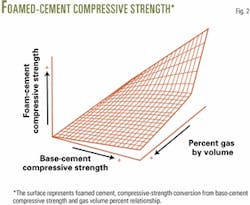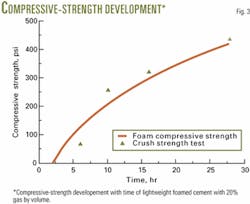Method predicts foamed-cement compressive strength under temperature, pressure
Extensive laboratory testing and data analyses reveal that the oil and gas industry can reliably estimate foamed-cement sample compressive strength, if the design engineer knows the compressive strength of the base cement and the percent gas by volume.
Operators can now obtain compressive-strength data for foamed cements with computer software and standard laboratory instrumentation, saving both time and expense.
The technique uses standard ultrasonic cement analyzer (UCA) data for the base cement and a new, multivariant strength correlation developed with laboratory data gathered from testing a wide range of foamed cements at atmospheric pressure.
Foamed cement
The introduction of foamed cements almost 3 decades ago solved many prob lems associated with cementing across weak formations; but foamed cements brought difficulties of their own that the industry is still resolving.
Before the use of foamed cement, in areas where weak zones would support only a limited height of normal-density cement without breaking down, the op erator had two choices:
- Run ultralightweight cement diluted with water, leaving a very weak column of cement.
- Run multiple-stage cement jobs to provide the required cement sheath height without producing a hydrostatic pressure that would fracture the formation.
These complicated multiple applications of cement could be very time-consuming and expensive, and they did not always provide adequate long-term integrity.
The development of foamed cements allowed creation of cements with densities as low as 8.0 ppg, far below the typical 11.5 ppg of a lightweight, nonfoamed cement.
Foamed cements have, in recent years, gained broadened use with operators to include such critical applications as inhibition of shallow water flows in deepwater well completions.
Traditional technique
Laboratories have traditionally used two techniques to determine compressive strength of oil well cements.
The oldest technique is the procedure of pouring a sample of the cement slurry into cube or cylinder molds and curing it according to American Petroleum Institute (API) guidelines.
Technicians remove the specimen after a specified time (12 hr, for example), crush it in a press, and record the compressive strength as the maximum stress required to break the specimen.
As an alternative to destructive, compressive-strength testing, technicians can analyze the cement with use of a UCA instrument.1 2 The UCA uses an empirical relationship between the velocity of an acoustic pulse through a cement sample and the sample's compressive strength.
The acoustic technique allows for easy measurement of compressive strength development with time at typical well temperatures and pressures. Acoustic measurements also yield other cement properties, such as static gel strength analysis (SGSA).3
The ability to perform strength measurements at downhole temperature and pressure and generate a continuous stream of measurements over time are key advantages of UCA and SGSA instruments.
Engineers can obtain numerous strength measurements from a single sample using nondestructive technologies and, in some cases, run UCA tests for months at a time.
By comparison, because the test destroys the sample, the cube test generates a single data point per sample. Also, the laboratory must perform the standard cube test at atmospheric conditions rather than at downhole temperature and pressure.
Although the UCA instrument is more effective than cube tests for analyzing standard cement slurries, it cannot suitably measure the compressive strength of foamed cements.
Gas bubbles in the foam attenuate the acoustic signal, resulting in poor signal quality.
Additionally, because pressure affects the volume of the foamed cement drastically, technicians must generate the foamed-cement sample in-or transfer it to-the high-pressure UCA cell or curing chamber.
Few laboratories have the specialized equipment required for high-pressure generation and transfer of the foamed cements. Even in laboratories with high-pressure equipment, the accuracy of compressive strength tests performed with a destructive crush test is questionable.
When technicians remove a sample from a curing chamber (as required to crush a cube sample), the entrained gas in the foamed cement expands, damaging the cement matrix and resulting in a compressive-strength measurement that is somewhat lower than the sample's actual compressive strength.
New technology
A new method provides an effective and inexpensive test for predicting the compressive strength of foamed cement at elevated temperature and pressure as a function of time.4
The method determines the foamed-cement compressive strength as a function of the base, unfoamed-cement compressive strength and of the percentage gas in the foamed cement.
Technicians then apply a multivariant correlation to the base compressive-strength data to predict the compressive strength of the foamed cement under the same conditions.
Workers can obtain the compressive strength of the base cement by any method.
The authors recommend a UCA for this task, however, because technicians can compute the foamed-cement compressive strength with time as the cement sets, provided they know the gas volume percentage.
Various authors have demonstrated that technicians can use parametric measurements to estimate a cement sample's physical quality.
Rao and Sutton demonstrated that the industry could predict cement compressive strength accurately from the acoustic signal transit time in the cement.1
Sabins and Maki demonstrated that workers could also predict the gel strength of the cement from the acoustic signal attenuation.5
Engineers developed each of these parametric measurements with standard laboratory measurements, establishing the relationship between the parametric value and the physical quality to be measured.
Method development
In formulating the new foamed-cement analysis process, researchers tested samples of cement with various den sities, additives, and amounts of entrained gas, preparing each of the samples according to API procedures.
Technicians measured the compressive strength of each sample with a crush test.
Workers also measured the base cement, containing no gas, with a UCA to confirm the accuracy of the compressive-strength measurement gathered with acoustic techniques.
Engineers used a best-fit mathematical function to estimate foamed-cement compressive strength for values of base-cement compressive strength and as a function of gas concentration.
Fig. 1 shows some of the foamed-cement compressive strength curves for 9%, 20%, 29%, and 40% gas by volume which researchers used to develop the new compressive-strength estimation process.
The regression analyses of the curve fits resulted in R-squared statistics ranging from 0.91 to 0.96, showing excellent correlation between the empirical data and the mathematical regressions.
Engineers then generated an interpolation surface by creating a third axis of gas volume percent (Fig. 2).
After measuring base-cement compressive strength and inputting the gas volume percent, one can derive the resulting foamed-cement compressive strength from the surface function.
A computer program implements the conversion with use of standard surface-mapping mathematics.
Fig. 3 shows the foamed cement, compressive-strength development with time, which was derived from standard UCA data and the surface function (Fig. 2).
The graph also shows cube-crush strengths for the same cement mix. These crush data verify the accuracy of the newly foamed, cement compressive-strength estimation process that employs the base-cement compressive strength and gas volume percent.
Researchers have shown the evaluation of other variables (for example set time) to be much less significant in determining the ultimate foam-cement compressive strength.
The multivariant correlation process provides the design engineer with reliable foamed cement compressive-strength estimates, in a much more efficient and cost-effective manner than previously possible, with use of industry standard laboratory instrumentation.
References
- Rao, P., and Sutton, D., "Method and Apparatus for Nondestructive Testing of Cement," US Patent 4259868, 1981.
- Rao, P., and Moon, J., "High Pressure-High Temperature Autoclave System For Testing Fluid Samples Ultrasonically," US Patent 4567765, 1986.
- Moon, J., and Wang, S., "Acoustic Method for Determining the Static Gel Strength of Slurries," paper SPE 55650, presented at the SPE Rocky Mountain Regional Meeting, Gillette, Wyo., May 15-18, 1999.
- Cobb, S., Maki, V., and Sabins, F., "Method for Predicting Compressive Strength of Foamed Cement Under Temperature and Pressure," US Patent 6345535, 2002.
- Sabins, F., and Maki, V., "Acoustic Method For Determining The Static Gel Strength of a Cement Slurry," US Patent 5992223, 1999.
The authors
Steve Cobb is president of Chandler Engineering Co. LLC. Previously, he was vice-president of Carbo Ceramics Inc. and has more than 20 years of experience in the energy industry. He holds a BS in geology from the University of Michigan, Ann Arbor, an MS in geological engineering from the University of Arizona, Tucson, and an MBA from the University of Dallas.
Voldi Maki is the owner of Measurement Group. Previously, he was a senior member of Halliburton Energy Services' technical staff. He has 30 years of experience designing acoustical systems. He holds a BS in electrical engineering from the University of Texas, Austin.
Fred Sabins is president of Cementing Solutions Inc. (CSI). Since starting his carreer in 1978, he has served as manager of cementing research for Halliburton Energy Services, Houston, vice-president cementing technology for Benchmark Research & Technology Inc., Houston, and manager cementing for Westport Technology Center International, Houston. He holds an MS in petroleum engineering from the University of Oklahoma, Norman. He is a member of SPE.






